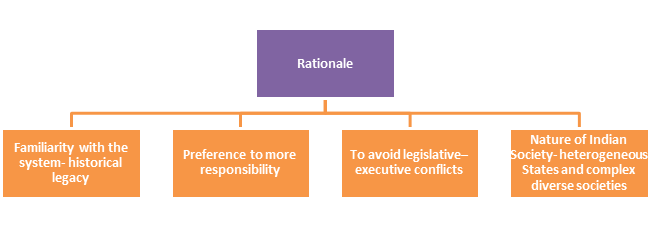Parliamentary System vs Presidential System
| Basis | Parliamentary System | Presidential System |
|---|---|---|
| Executive | Dual executive- real and nominal head | Single executive- President as formal and real head. |
| Rule | Majority party rule | President and legislators elected separately for a fixed term |
| Responsibility | Collective responsibility | Non-responsibility |
| Political homogeneity | Political homogeneity | Political homogeneity may not exist |
| Membership | Double membership | Single membership |
| Leadership | Leadership of prime minister | Domination of president |
| Dissolution of Lower House | Dissolution of Lower House | No dissolution of Lower House |
| Balance of power | Fusion of powers | Separation of powers |
Parliamentary form of government
| Advantages | Disadvantages |
|---|---|
| • Harmony between legislature and executive • Responsible government • Prevents despotism- system of checks and balances • Wide representation | • Unstable government • No continuity of policies • Against separation of powers • Prone to prime-ministerialisation of government due to dominance of PM. |
Presidential form of government
| Advantages | Disadvantages |
|---|---|
| • Stable government • Definiteness in policies and possibility of bold reforms • Based on separation of powers • Fixing of responsibility • Government by experts | • Conflict between legislature and executive • Non-responsible government • May lead to autocracy • Narrow representation • Dominance of personality over party |
Indian parliamentary democracy
About
-
- Article 74 and 75 – Parliamentary system of government at the Union level
- Article 163 and 164 – Parliamentary system of government at the States level.
- Borrowed from the Government of India Act 1935
- Also known as Cabinet government, Responsible government, Westminster model.
- Based on collective responsibility
Features
-
- President (Nominal executive) and Prime Minister (Real executive)
- Majority party rule
- Collective responsibility (Article 75)
- Political homogeneity
- Double membership- ministers are members of both legislature and executive
- Leadership of the Prime Minister
- Dissolution of the Lower House
- Secrecy- oath of secrecy to the ministers
Rationale

Concept of responsible government
-
- A cabinet form of government
- Council of minister headed by PM as decision-making body.
- Council of minister be collectively and individually responsible to lok sabha under Article 75
- Executive belongs to legislature
- Dominance of party system over personality system
- Layers of responsibility like elections, appointment and removal of ministers, answerability of ministers, legislative control over executive.
Working of parliamentary system in India
| Positives | Negatives | Way forward |
|---|---|---|
| • Biggest democracy in the world • Greater decentralization- 73rd and 74th amendment acts • Diverse representation at grassroots level by reservation | • Criminalization of politics • Political defections • Declining quality of debates • Diminishing number of sessions (60-70 days) • Electoral malpractices and corruption • Inadequate representation (~14% of women MPs) | • Promote internal party democracy • Electoral reforms • Simultaneous elections • Introduce direct election of mayor with devolution of power |
Whether India should adopt presidential form of government?
| Need | Not feasible as | Conclusion |
|---|---|---|
| “Super cabinet” and strong PM- Prime-ministerialisation of democracy Inefficiencies and drawbacks of coalition government. Lack of stability in governments- mid-term elections and poor decision making | Diverse population require consensus building Mere domain expertise may not ensure independent and impartial advice. Parliamentary system a basic structure of the Constitution. | Swaran Singh Committee: Parliamentary system is working well and no need to replace. System of government does not ensure prosperity rather its effective working. |

